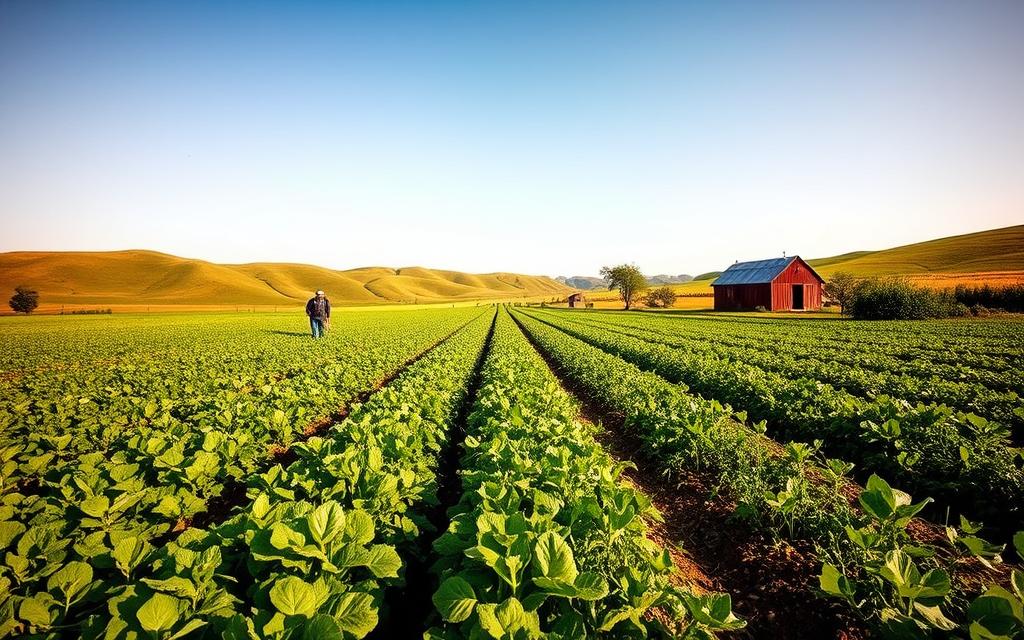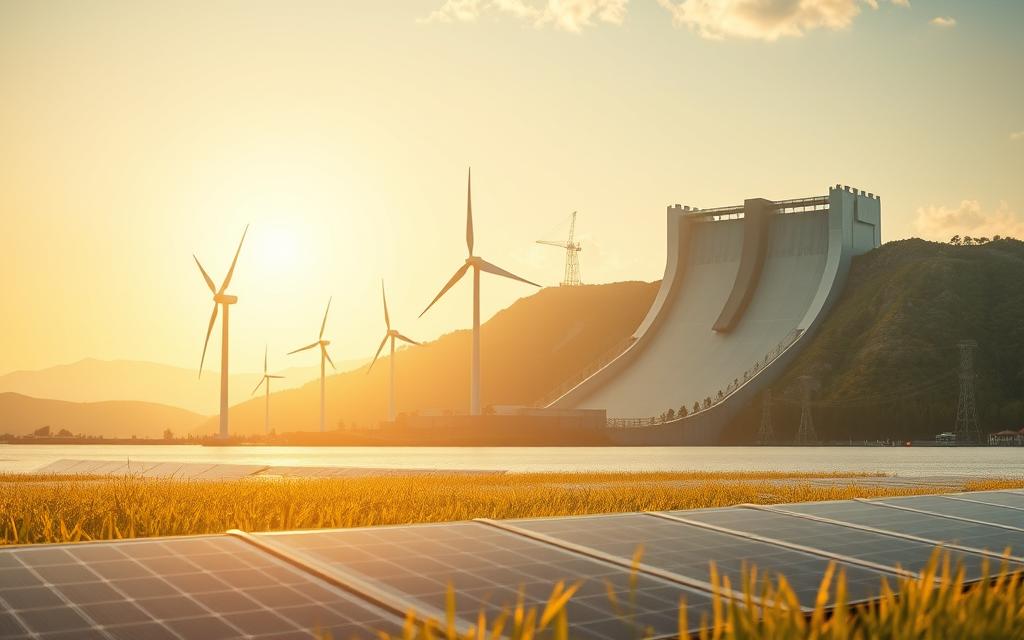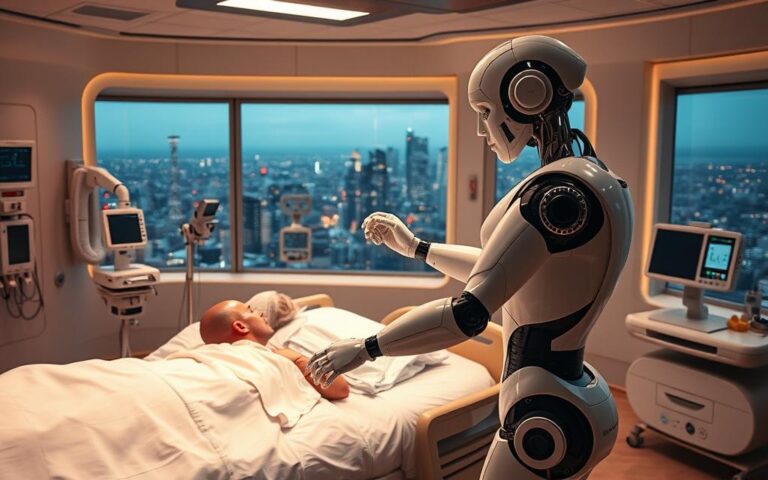In 2020, renewable energy sources made up more than 80% of new global power capacity. That’s according to the International Renewable Energy Agency. It shows how important green technology is in fighting climate change. It also shows how vital it is for sustainability worldwide.
We urgently need to tackle using up resources and harming the environment. That’s where sustainable technology comes into play in our daily lives.
This article talks about the latest in green tech designed for a sustainable future. We dive into renewable energy, eco-friendly actions, and cutting-edge tech. We will look at how these efforts can lessen environmental harm and improve our lives.
Understanding Sustainable Technology
Sustainable technology is crucial for a greener future. It includes innovations that reduce environmental harm while meeting our needs. These include renewable energy, sustainable farming, and efficient manufacturing. We need to understand these ideas to tackle climate change and environmental harm.
Definition and Key Concepts
Sustainable technology aims for long-lasting environmental health. It focuses on renewable energy to cut carbon emissions. By using these eco-friendly methods in areas like transport and building, we can meet today’s needs without harming the future.
Importance in Today’s World
The role of sustainable technology is more critical now than ever. With environmental problems threatening our world, we must adopt sustainable methods. These technologies help protect ecosystems and support eco-friendly lifestyles. They balance economic growth with caring for our planet, leading us toward a sustainable future.
The Role of Renewable Energy
Renewable energy is key to a green future. It let us use less fossil fuels. This cuts climate change and leads to cleaner energy. Solar, wind, and geothermal sources are very promising. They are game changers in green tech.
Solar Power Innovations
Solar tech has grown by leaps. Now, we have better solar panels. Also, things like solar roads and windows are here. They don’t just make electricity; they make cities more energy-smart. So, using solar energy in many ways is a big step towards a green future.
Wind Energy Developments
Wind energy has come a long way. Offshore farms use the sea’s winds for lots of power. And, new turbine designs take up less space but work better. So, wind energy is becoming a top choice for clean energy. It’s beating old-school power sources.
Geothermal Energy Solutions
Geothermal energy comes from Earth’s heat. Now, we can get heating and power directly from the ground. It’s a clean, always-on energy source. Using geothermal energy cuts carbon emissions. It’s a big part of moving towards a sustainable world.
| Energy Type | Key Innovations | Benefits |
|---|---|---|
| Solar Power | Solar panels, solar roads, solar windows | High efficiency, reduced carbon footprint |
| Wind Energy | Offshore wind farms, vertical-axis turbines | Reliable energy, lower operational costs |
| Geothermal Energy | Geothermal heat pumps, enhanced geothermal systems | Consistent energy supply, low emissions |
Energy Efficiency in Industries
Energy efficiency helps industries cut costs and protect the environment. The rise of smart manufacturing lets businesses use tech to be more efficient. By using energy-saving tech, companies can work smarter, waste less, and help build a more sustainable world.
Smart Manufacturing Processes
Smart manufacturing uses automation, IoT, and data analytics to better manage production. These tools improve energy use by watching equipment closely, spotting problems early, and using energy wisely. Automated systems also cut downtime and boost production, fitting with eco-friendly industry goals.
Energy-Efficient Appliances
Energy-efficient appliances greatly cut power use in factories. Tools like variable frequency drives, LED lighting, and high-tech HVAC systems save a lot of energy. Using these technologies not only reduces bills but also makes operations more reliable and effective.
Case Studies of Major Brands
Leading companies have made energy efficiency a key part of their production. For example, Siemens and General Electric have slashed energy use with smart manufacturing. Their innovative approaches and smart investments show that focusing on energy efficiency can reduce emissions and strengthen their market position in a green future.
Sustainable Transportation Solutions
The push for sustainable transportation is tackling major environmental issues. It involves electric vehicles, better public transit, and supporting biking and walking. These steps are key for greener travel. They cut down carbon emissions and make the air cleaner.
Electric Vehicle Advancements
Electric vehicles are on the rise as companies create new models for everyone. Tesla, Nissan, and Chevrolet lead the way in changing how we use cars. They offer energy-efficient choices that cut down on fossil fuel use. More and more places to charge these cars are popping up, too.
Public Transit Innovations
Big changes are happening in public transit. Cities are adding electric buses and green solutions. This makes travel smoother and cuts down pollution. People find public transit more reliable, so they’re giving up their cars for shared rides.
Biking and Walking Initiatives
Cities want to make biking and walking easier. They’re setting up bike lanes and paths just for walking. And bike-sharing programs are everywhere. This helps cut pollution and makes life better for everyone.
| Transportation Mode | Environmental Impact | Examples |
|---|---|---|
| Electric Vehicles | Low emissions, reduced reliance on fossil fuels | Tesla, Nissan Leaf, Chevrolet Bolt |
| Public Transit | Significant emissions reduction, efficient use of resources | Electric buses, metro systems |
| Biking/Walking | No emissions, promotes physical health | Cycling paths, pedestrian zones |
Eco-Friendly Building Practices
In recent years, there’s been a big shift towards eco-friendly building. People are now focusing on reducing harm to the environment while making places better to live. This change has led to the use of green building methods and designs that save energy. As a result, our buildings and communities are becoming healthier.
Green Construction Materials
Choosing green materials like bamboo, recycled steel, and reclaimed wood is key in sustainable building. These materials help cut down on waste and support local jobs by using nearby resources. By doing this, buildings leave a smaller carbon footprint, making construction more eco-friendly.
Energy-Efficient Designs
Today’s buildings are designed to use less energy. By adding better insulation, windows that save energy, and smart technology, buildings need less power. Making these smart choices not only reduces power bills but also helps the environment.
LEED Certification and Its Benefits
LEED certification is a top honor for green building efforts. Getting this certification proves a dedication to being eco-friendly. It brings benefits like lower operating costs, higher property values, and better chances of being chosen by buyers or renters. It motivates builders and developers to focus on green building and saving energy.
Water Conservation Technologies
The need for water is growing, but new water-saving technologies are making a difference. They help us use less water, ensuring there’s enough for everyone in the future.
Smart Irrigation Systems
Smart irrigation systems are changing the way we water our crops. They use sensors to check the soil and weather. This means farmers only water crops when needed, reducing waste.
This technology not only saves water but also makes crops grow better.
Water Recycling Innovations
Recycling water is key to using it wisely. Systems that recycle greywater from our homes for use in gardens are gaining popularity. They clean the water so it’s safe again.
Recycling cuts down our need for fresh water. This is a smart way to support our communities.
| Technology | Benefits | Applications |
|---|---|---|
| Smart Irrigation Systems | Reduces water waste, Increases crop efficiency | Agriculture, Landscaping |
| Greywater Recycling | Reuses domestic water, Lowers freshwater demand | Residential, Commercial |
| Advanced Water Treatment | Produces clean, safe water for reuse | Industrial, Municipal |
Waste Management Innovations
Innovations in waste management are crucial for a sustainable future and addressing environmental issues. We are now moving towards a circular economy. This focuses on reusing things and using less single-use items.
Circular Economy Practices
The circular economy helps sustain production and consumption. It keeps resources in use as long as possible. Businesses and communities are encouraged to use less and waste less. This is done through product take-back programs and recovering materials. Such efforts reduce waste going to landfills and improve resource use.
Composting and Recycling Technologies
New composting and recycling methods are changing waste management. For instance, in-vessel composting speeds up the breakdown of organic waste. This makes compost that helps crops grow. Also, new recycling tech helps us sort and reuse plastics, metals, and paper better. These advances show waste can be an asset, not just trash.
Case Studies on Cities Reducing Waste
Many cities have shown how innovative waste management can work. Here are some examples:
| City | Waste Reduction Initiatives | Results |
|---|---|---|
| San Francisco | Mandatory recycling and composting laws | 55% waste diversion rate |
| Kamikatsu, Japan | Zero waste goal with 45 waste categories | 80% waste diversion rate |
| Capannori, Italy | Pay-as-you-throw waste system | 25% reduction in per capita waste generation |
The Importance of Sustainable Agriculture
Sustainable agriculture is key to solving environmental issues from traditional farming. It boosts soil health, biodiversity, and cuts greenhouse gases. This leads to better food production systems. Vertical farming is one way to achieve this. It grows crops in stacked layers in controlled settings. This saves space and resources.
Vertical Farming Techniques
Vertical farming grows food in stacked layers with the help of technology. It uses less land and cuts down on transport emissions by being closer to cities. There are several important technologies in vertical farming:
- Hydroponics: Growing plants in water with nutrients.
- Aeroponics: Spraying plant roots with nutrient solutions for more oxygen.
- Light Emitting Diodes (LEDs): Special lights that help plants grow inside.
Organic Farming Practices
Organic farming relies on natural processes and avoids synthetic stuff. It’s better for the planet and matches what people want from their food. The perks of going organic include:
- Better soil from compost and rotating crops.
- More wildlife on farms due to varied plants and animals.
- Fruits and veggies that are often more nutritious.
Agricultural Technology Advancements
Technology is changing sustainable agriculture for the better. Tools like drones and soil sensors help farmers check on crops and use resources wisely. This leads to more crops and less harm to the environment.

The Future of Sustainable Technology
The future of sustainable technology is exciting. We see many new ideas to tackle environmental issues. These include using artificial intelligence and blockchain with renewable energy. This makes energy use more efficient and open.
These steps make it easier to use green energy. They help different sectors become more eco-friendly. With new tech, using green energy is becoming easier. This means a better future for everyone.
Rules and laws are important for eco-friendly technology. Governments can help by encouraging the use of green tech. They might offer tax breaks for renewable energy investments. Or, they might give grants to buy electric cars. These actions can change the market.
Understanding these policies helps build a strong foundation. This supports our move to a more sustainable way of living.
We can all play a part in this change. Support businesses that are kind to the environment. Push for laws that protect our planet. Use green tech in your everyday life.
Our individual actions matter. They add up to a big difference. Together, we can move towards a more sustainable future.




